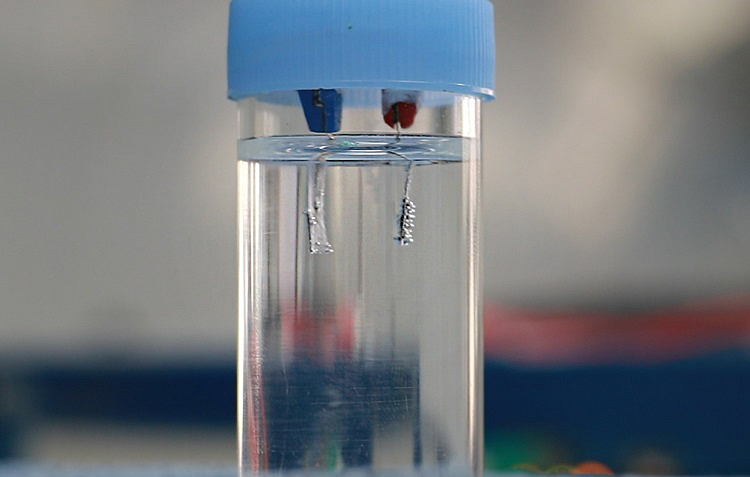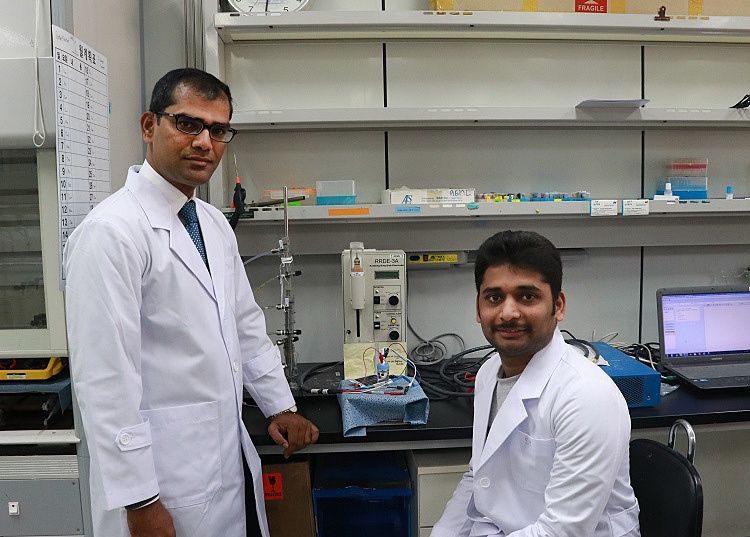Researchers with the Daegu Gyeongbuk Institute of Science and Technology (DGIST) (Daegu, South Korea) and the U.S. Pacific Northwest National Laboratory (PNNL) (Richland, Washington, USA) are developing a thin carbon coating for electrocatalysts that they believe can be a cheaper alternative to the traditional noble metal anode electrode used in water splitting.1
The researchers say their new nanostructured catalyst can reduce the rate of carbon-induced corrosion often experienced in alkaline water electrolysis, used to produce hydrogen from renewable resources.
“We anticipate this to be a unique approach to developing metal-rich, reduced-carbon composite nanostructures that have enhanced metal active sites, which feature thin carbon layer protection and ultra-fast electron movement in the catalyst surface,” says Sangaraju Shanmugam, a DGIST energy science and engineering professor. “That will enhance the electrochemical activity and stability of electrocatalysts.”
The electrolysis process effectively splits water into hydrogen and oxygen in a unit called an electrolyzer. According to the U.S. Department of Energy (Washington, DC, USA), electrolyzers used in hydrogen production consist of an anode and a cathode separated by an electrolyte. With a sufficient potential difference, oxygen gas can be produced at the anode and hydrogen gas at the cathode.
Carbon Corrosion Concerns
In electrocatalytic water splitting, the oxygen gas generates in the anode due to the oxygen evolution reaction (OER). However, it is a slow reaction as compared with the hydrogen evolution reaction (HER). In this delay, chemicals produced during the electrolysis process can corrode the electrode material. Thus, suitable electrocatalysts—and coatings to protect them—are needed to expedite the timetable and protect the electrode material during the OER phase.
According to the researchers, the field of electrochemical energy generation, or conversion, has recently received major attention, brought on by rising environmental concerns. As such, the OER process plays a vital role in commercializing renewable energy technologies such as fuel cells and water electrolyzers.
To date, ruthenium oxide (RuO2) and iridium oxide (IrO2) have been used most frequently as coatings for electrodes in water electrolysis. However, most of these catalysts have featured higher carbon content and less metal content, the researchers say. As such, this resulted in faster carbon-induced corrosion conditions during the OER, leading to reduced stability and issues with scalability.
“In the previous research, researchers have prepared the carbon-coated metals from various precursors, including metal-organic frameworks,” Shanmugam says. “The obtained catalysts exhibit more carbon with less graphitic nature, and the carbon covered the active metal sites. Also, due to the substantial carbon corrosion, those catalysts are not suitable enough for the sluggish OER in water splitting.”
New Nanosized Approach
To address the problem, DGIST and PNNL researchers encapsulated an electrocatalyst on nickel foam with a metal-rich, thin-nanocarbon layer to replace the usual noble metal anode electrode.

Using a Prussian blue analogue, researchers found that a large amount of inorganic cobalt metal ions and organic ligands in the salt were a suitable precursor for core-shell electrocatalysts. When heated to 600 to 900 °C in an inert atmosphere, the cobalt metal ions and organic ligands were transformed into cobalt metal and nitrogen-doped, graphitic layers of thin carbon.
“The thin carbon layers have a strong interaction with cobalt metal, which can promote less carbon corrosion, excellent electron movement, and more cobalt metal exposure to the reaction medium, including the formation of nanosized morphology without particle aggregation,” Shanmugam says.
In potential measurements from their study, an IrO2–anode water electrolyzer showed a cell voltage loss of 230 mV (14%) at 95 h. Meanwhile, the loss of the electrolyzer utilizing the new approach was only 60 mV (4%), even after 350 h.
“The [new approach] showed enhanced oxygen evolution activity and ultrastability on the current collector of nickel foam,” Shanmugam explains. “Overall, the thin and uniform carbon layers provide the fast electron movements with easy electrolyte penetration. Most importantly, it can protect the active metal sites from corrosion with minimal exposing.” He adds that strong interaction between the metal and carbon layers exhibits a synergistic effect, leading to enhanced activity and reduced carbon oxidation.
Steps to Commercialization

Going forward, Shanmugam expects the process of large-scale commercialization to take at least a year. “We have to make the uniform coating of this catalyst on the larger size current collectors without any peeling off,” he says. “So, we need to find the most suitable coating methodology.”
In addition, the professor believes more follow-up studies are needed to understand the exact OER mechanisms taking place on the surface when utilizing the new approach.
“We have to understand the precise OER mechanisms on these electrocatalysts to maintain or avoid activity losses due to unwanted side reactions,” Shanmugam says.
In the grand scheme, the goal of his research is to enable the production of “green” and sustainable hydrogen on a larger scale than is currently available.
Source: DGIST, en.dgist.ac.kr. Contact Sangaraju Shanmugam—email: sangarajus@dgist.ac.kr.
Reference
1 “High-Efficient and Low-Cost Catalyst for Water Electroysis,” DGIST Research News, Feb. 12, 2018, https://en.dgist.ac.kr/site/dgist_eng/menu/508.do?siteId=dgist_eng&snapshotId=3&pageId=429&cmd=read&contentNo=36671 (May 14, 2018).